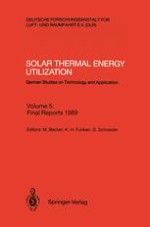1991 | Book
Solar Thermal Energy Utilization
German Studies on Technology and Application
Editors: Dr.-Ing. Manfred Becker, Dr. rer. nat. Karl-Heinz Funken, Dipl.-Ing. Gernot Schneider
Publisher: Springer Berlin Heidelberg
Included in: Professional Book Archive
